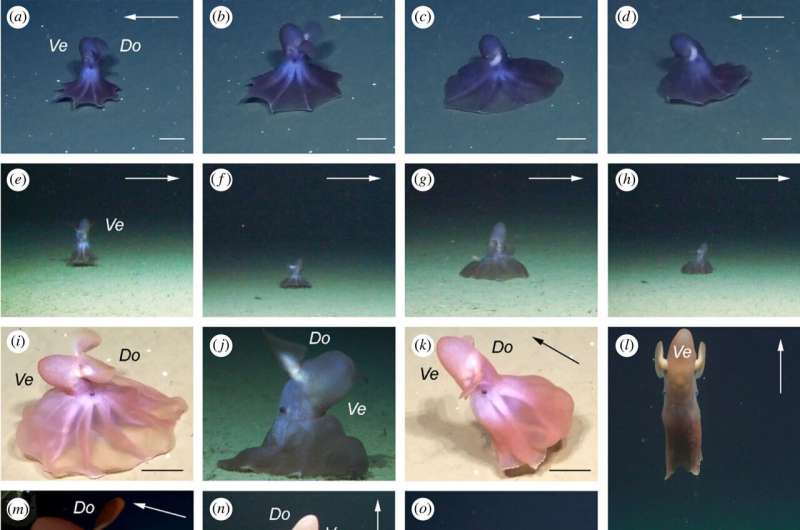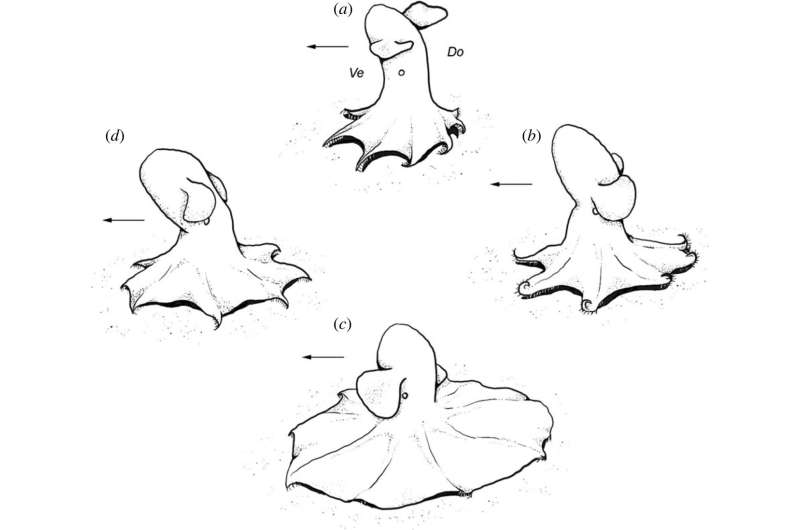
In the marine realm, diel vertical migration is a common feeding pattern: During daytime, zooplankton, fish and other marine life that feeds on these organisms hide in the darker depths of the ocean.
At night, when there is less light, they rise to the surface to hunt for prey. Researchers from GEOMAR Helmholtz Centre for Ocean Research Kiel, Senckenberg am Meer—German Centre for Marine Biodiversity Research, Alfred Wegener Institute, Helmholtz Centre for Polar and Marine Research (AWI) (all Germany) and REV Ocean (Norway) observed octopuses in the Arctic taking the opposite route: Videos recorded with remotely operated vehicles and towed in-situ observation systems in the Arctic suggests that the "dumbo" octopus Cirrotheutis muelleri migrates from the water column to the sea floor, where it catches crustaceans and polychaetes.
"It is the first time, images of Cirrotheutis muelleri octopuses have been analyzed in such detail," emphasizes Dr. Alexey Golikov. The deep-sea biologist at GEOMAR Helmholtz Centre for Ocean Research Kiel is lead author of the recent publication in Proceedings of the Royal Society B that describes the newly-observed octopus behavior.
"On the one hand, we saw these animals drifting freely in various depths of the water column with their arms and web spread out widely, in an umbrella-like posture—a very energy-efficient and stealthy way to roam their environment. But then there was this very distinct feeding pattern: Using their wing-like fins, they swim slowly above the sea floor, suddenly land to envelop their food with their arms and web and take off with their meal, flapping heavily."

In addition, the researchers found many marks in the sediment that were interpreted as traces from such landing and prey envelopment.
The process was recorded during several expeditions with the research vessels Polarstern, Maria S. Merian, Sonne and Kronprins Haakon in the Arctic Ocean between 2019 and 2022, using the remotely operated vehicles ROV Phoca, ROV Kiel 6000 and Aurora Borealis as well as the Pelagic In-Situ Observation System (PELAGIOS) and the Ocean Floor Observation System (OFOBS).
To confirm the observed behavior shows a feeding habit, the researchers checked it against data on stomach contents of individuals caught with bottom nets.
"By analyzing the unique imagery from various expeditions that was available to us, we were able to reveal another secret of the deep sea, providing further proof that there is still so much to discover," says Dr. Henk-Jan Hoving, head of the deep-sea biology working group at GEOMAR. "Cirrotheutis muelleri is a very common octopus species in the Arctic. To our knowledge, its downward migration that runs in the opposite direction to the common vertical migration is unique among cephalopods. So far, it is only known for certain fish and holothurians."
The authors also suggest that the counter-directional migration may function as another link between the upper layers and the sea floor. It introduces carbon from the benthic food web to the pelagic food web and may contribute to the energy transfer to larger predators such as sharks and deep-diving toothed whales that feed on cirrate octopuses. In addition, the passive movements covering several kilometers should be considered in conservation strategies.
More information: Alexey V. Golikov et al, Miles down for lunch: deep-sea in situ observations of Arctic finned octopods Cirroteuthis muelleri suggest pelagic–benthic feeding migration, Proceedings of the Royal Society B: Biological Sciences (2023). DOI: 10.1098/rspb.2023.0640
Provided by GEOMAR Helmholtz Centre for Ocean Research Kiel
Citation: Deep-sea imagery and observations reveal novel octopus feeding behavior (2023, July 13) retrieved 13 July 2023 from https://ift.tt/ZnRLGI3
This document is subject to copyright. Apart from any fair dealing for the purpose of private study or research, no part may be reproduced without the written permission. The content is provided for information purposes only.
"behavior" - Google News
July 14, 2023 at 12:23AM
https://ift.tt/ZucQBlG
Deep-sea imagery and observations reveal novel octopus feeding behavior - Phys.org
"behavior" - Google News
https://ift.tt/NlHWrxK
Bagikan Berita Ini














0 Response to "Deep-sea imagery and observations reveal novel octopus feeding behavior - Phys.org"
Post a Comment